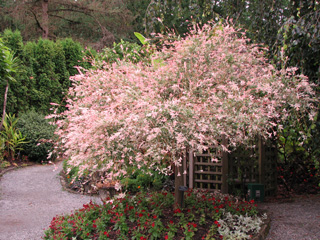Resource Library
Plant of the Week: Willow, Dappled

The pink new growth of the Dappled Willow flashes like neon during spurts of growth during the spring and summer. (Image courtesy Gerald Klingaman)
Download High Resolution
Dappled Willow
Latin:Salix integra ‘Hakuro-nishiki’
FAYETTEVILLE, Ark. -- Willows have always intrigued me, and as I learn more about them, their toughness and diversity is one of their charms.
The dwarf mountaintop species that grow a few inches tall form an interesting counterpoint to the large, fast growing weeping willows commonly seen in our gardens. But most of the 400 willow species are shrubs, making large multiple stemmed blobs in the landscape. The dappled willow (Salix integra ‘Hakuro-nishiki’) is one of these shrub willows that has many of the ornamental features gardeners are looking for when they plant a shrub.
The coyote willow – the common name used for the species in the United States because coyotes often dig dens in thickets of the plant – is native to the western half of North America and across large swaths of Siberia, Korea, Japan and China where it grows in lowland sites to high elevations along mountain lakes. It is a multiple-branched, root suckering deciduous shrub growing to 20 feet tall with typical willow-like leaves 3 to 5 inches long and an inch wide. Shrubs take on a weeping form as they get older. Tawny yellow 2 to 3 inch long catkins appear with the leaves in the spring and are not especially showy. It typically is found at the water-edge but will grow in drier sites when planted there.
The coyote willow is an important plant from both an ethno-botanical and ecological standpoint. Because it is heavily browsed by deer and elk, it tends to have lots of new, slender, straight stems that make it ideal for weaving. The twigs are stripped of their bark in early spring as the sap rises and then used as the warp for woven baskets and other weaving projects. Roots were dug and the bark used for sewing thread by Native Americans. Willow bark and leaf teas have been used widely among native peoples for centuries in a number of medicinal settings, most notably as a naturally occurring aspirin.
The dappled willow cultivar ‘Hakuro-nishiki’ produces startling bright pink flushes of new growth. On closer inspection the leaves will consist of combinations of pink, white and green that transition to white flecks on the field of green as the leaves mature. Whenever the plant makes a flush of new growth during the growing season, the flash of pink can be as colorful as blossoms. The plant care tags list this plant as growing 4 to 6 feet tall, a gross misrepresentation of its true potential which is usually twice that. It is sometimes grafted on a 5-foot-tall stem, providing the framework for a small weeping tree if judicious pruning is done.
The origins of this cultivar are obscure. It is said to be synonymous with an older cultivar called ‘Albo-maculata’, meaning it has probably been around for a century or more but was probably reintroduced into the U.S. during the 1980s from Japan using the cultivar name used in that nation. ‘Flamingo’, itself a selection from ‘Hakuro-nishiki’, is a “new and improved” clone that originated in the Netherlands in 1996.
The dappled willow is widely available in nurseries in the spring. It is suitable for use as a background plant in the shrub border, as a tall informal hedge, or as a unique specimen mixed with perennials. It is adapted from zones 4 through 9 but the best foliage color is produced in areas north of zone 7 where summertime night temperatures are lower. It grows best in full sun, perhaps with a bit of afternoon shade, and moderately moist soil. Severe late winter pruning is needed to keep the plant in bounds and to encourage new growth. Trimming the new growth back in midsummer will continue the spurt of new growth and colorful foliage.
By: Gerald Klingaman, retired
Retired Extension Horticulturist - Ornamentals
Extension News - February 28, 2014